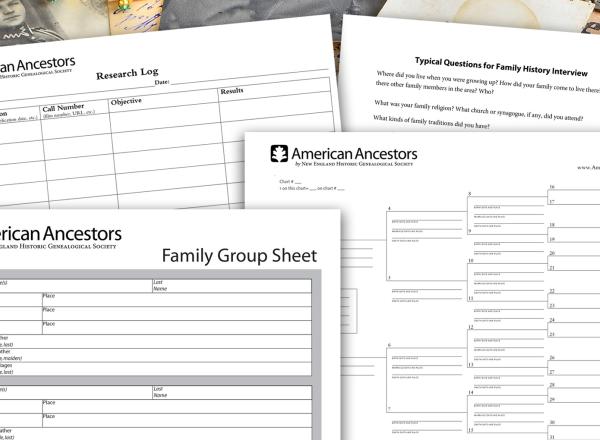Family historians rely on a number of organizational tools, including commonly used forms to record their research efforts and findings. Even though most genealogical software programs will export your findings into such formats, it is important to understand how each works and how they can be organized to best support future research. The following templates will help you organize your research, save you time, and present your information in a consistent and accurate way.

Family Charts
Five Generation Family Chart
A multi-generational chart provides a road map of your ancestors and includes basic information about each couple: full name and date and place of birth, death, and marriage. Each person on the chart receives a number. The subject of the chart is number 1; the subject’s father is 2, the mother is 3; the father’s father is 4, the father’s mother is 5; etc. Each chart is assigned a number and cross-referenced to connect charts and generations. Thus, every ancestor receives a unique number that can be used as shorthand or for filing. E.g., 3:6 refers to chart number 3, person number 6.
Family Group Sheet
A family group sheet provides a snapshot of each nuclear family and records pertinent information about each family member. This information may include:
- For father and mother: given and last name(s); birth, death, and marriage date and place; parents’ names; other marriages
- For children: sex, given and last name(s); birth, death, and marriage date and place; spouse’s name
Research Templates
Research Plan Template
A research plan provides a roadmap for your genealogical research. This easy-to-use template takes you through the process of forming a good research question, identifying which records help you answer the question, clarifying record availability for your time period and location, and listing specific repositories where the records may be found.
Research Log
Research logs are an excellent way to keep track of the research you have already accomplished. They contain a list of every source you consulted—and whether your search was successful or not. Handwritten or typed, these logs help prevent duplicate searches and lookups.
Annotated Research Log
This annotated research log (excel file) provides a starting point for you to track your research and stay focused on the genealogical issue at hand. You can easily add columns, rows, and sort your findings.
Interview Questions
Gather information about your family and ancestors by interviewing family members, friends, and neighbors. These suggested interview questions will help!
Family Questionnaire
Compile additional information for your research or publication by mailing or emailing relatives and family friends a questionnaire.
Early Census Comparison Charts
Beyond the head of household, early censuses provide little information about the individual members of a family. It can therefore be difficult to track families from one census to the next. Use these forms to help compare families between censuses.
- 1800-1810 census comparison
- 1810-1820 census comparison
- 1830-1840 census comparison, free white families
- 1830-1840 census comparison, free colored families
- 1830-1840 census comparison, slave families
Researching House History
Uncovering the history of a house may shed light on family dynamics, social class, historical context, material culture, and more. You may be surprised at what you find! Use the below forms to organize your house history research:
1950 U.S. Federal Census Worksheet
Use this worksheet to guide your research through the newly released 1950 U.S. Federal Census.
Writing & Publishing
Register Style Template
Format your article or book manuscript using Register style—a widely used genealogical format that's been used for more than 100 years. An editor looking over an article submitted for possible publication will be favorably impressed and will follow your text more easily when the material is presented in Register format. Read more about the Register
Ahnentafel Template
An ahnentafel, or ancestor table, begins at or near the present and follows a direct line of ancestors as far back as is traceable or for a certain number of generations. Each person is numbered. If you are tracing your own ancestry, you would be number 1, and each person would be numbered in a particular order from there: your father would be number 2 and your mother number 3; his parents would be 4 and 5; her parents would be 6 and 7, and so on. Men are always even and women are always odd. You double a person’s number to get his or her father’s number; you double the number and add 1 to get his or her mother’s number. This template will help you organize and format the content for each numbered couple.
Sample Stylesheet
This stylesheet is a sample only. Although many of the items listed reflect rules that American Ancestors follows, you need not match all exactly. Establish your own guidelines and, most important, be consistent! For punctuation, hyphenation, and other general style rules, refer to The Chicago Manual of Style.
Editorial Checklist
Use this resource to help refine your work and keep elements and styles consistent.
Drop Chart template
Use this template to construct an easy-to-follow visual aid showing direct descendancy—a perfect chapter opener!